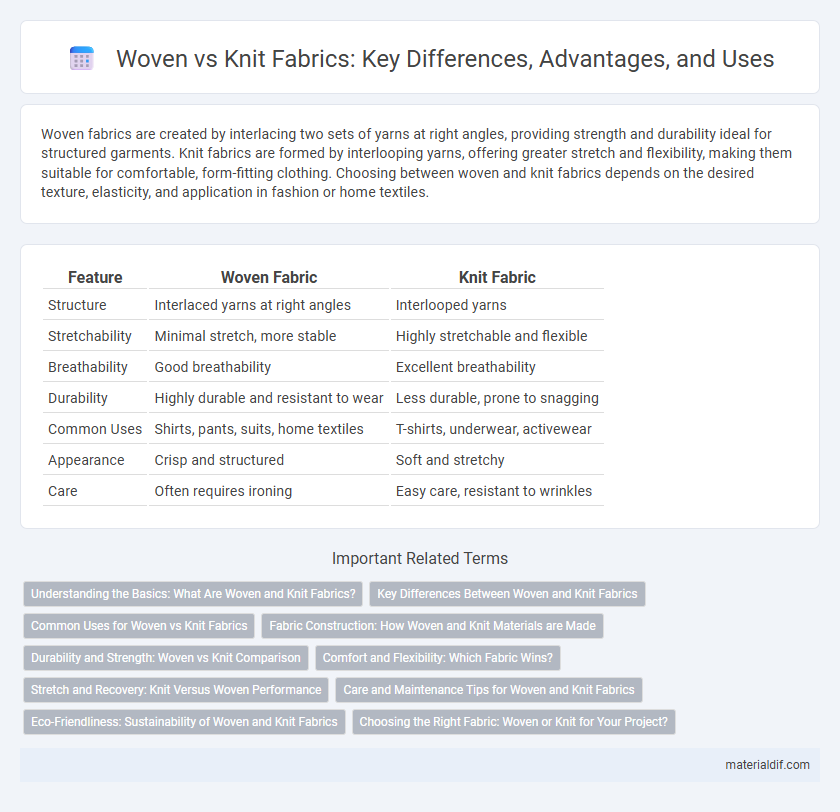Woven fabrics are created by interlacing two sets of yarns at right angles, providing strength and durability ideal for structured garments. Knit fabrics are formed by interlooping yarns, offering greater stretch and flexibility, making them suitable for comfortable, form-fitting clothing. Choosing between woven and knit fabrics depends on the desired texture, elasticity, and application in fashion or home textiles.
Table of Comparison
| Feature | Woven Fabric | Knit Fabric |
|---|---|---|
| Structure | Interlaced yarns at right angles | Interlooped yarns |
| Stretchability | Minimal stretch, more stable | Highly stretchable and flexible |
| Breathability | Good breathability | Excellent breathability |
| Durability | Highly durable and resistant to wear | Less durable, prone to snagging |
| Common Uses | Shirts, pants, suits, home textiles | T-shirts, underwear, activewear |
| Appearance | Crisp and structured | Soft and stretchy |
| Care | Often requires ironing | Easy care, resistant to wrinkles |
Understanding the Basics: What Are Woven and Knit Fabrics?
Woven fabrics are created by interlacing two sets of yarns at right angles, producing a structured, stable material often used for shirts and trousers. Knit fabrics consist of interlooped yarns, offering superior stretch and flexibility, commonly found in t-shirts and activewear. Understanding these construction methods is essential for selecting appropriate fabrics based on durability, comfort, and application requirements.
Key Differences Between Woven and Knit Fabrics
Woven fabrics consist of interlaced yarns arranged in a perpendicular pattern, providing a structured and firm texture ideal for durable garments and upholstery. Knit fabrics are created by interlooping yarns, resulting in stretchable, flexible materials favored for activewear and comfortable clothing. Key differences include breathability, elasticity, and wrinkle resistance, with woven fabrics offering less stretch but more stability, whereas knits provide superior flexibility and recovery.
Common Uses for Woven vs Knit Fabrics
Woven fabrics are commonly used for structured garments such as shirts, trousers, and jackets due to their durability and firm texture. Knit fabrics are preferred for activewear, t-shirts, and casual clothing because of their stretchability and comfort. Both fabric types serve distinct purposes based on their construction, with woven fabrics excelling in formal wear and knit fabrics dominating in apparel requiring flexibility.
Fabric Construction: How Woven and Knit Materials are Made
Woven fabrics are created by interlacing two sets of yarns at right angles, producing a stable, structured material ideal for tailored garments and upholstery. Knit fabrics form by looping a single yarn continuously, resulting in a stretchable, flexible textile commonly used in activewear and casual clothing. The fundamental difference in construction affects breathability, elasticity, and durability, influencing fabric choice for specific applications.
Durability and Strength: Woven vs Knit Comparison
Woven fabrics exhibit superior durability and strength due to their tightly interlaced yarns, making them highly resistant to wear and tear in heavy-duty applications. Knit fabrics, while offering greater stretch and flexibility, tend to have lower tensile strength and may be prone to snagging or pilling under intense use. Selecting between woven and knit depends on the required balance of durability and elasticity for specific fabric applications.
Comfort and Flexibility: Which Fabric Wins?
Woven fabrics offer structured durability and maintain their shape well, providing moderate comfort but limited flexibility due to their tight interlacing of yarns. Knit fabrics excel in comfort and flexibility because their loops of yarn allow for stretch and movement, making them ideal for activewear and casual clothing. For superior comfort and adaptability, knit fabric consistently outperforms woven fabric in everyday wear.
Stretch and Recovery: Knit Versus Woven Performance
Knit fabrics offer superior stretch and recovery compared to woven fabrics due to their looped construction, allowing for greater elasticity and flexibility. Woven fabrics, created by interlacing yarns at right angles, provide limited stretch primarily on bias and demonstrate less recovery after deformation. This fundamental difference makes knits ideal for activewear and garments requiring comfort and movement, while wovens excel in structured apparel needing durability and shape retention.
Care and Maintenance Tips for Woven and Knit Fabrics
Woven fabrics require gentle washing with cold water and air drying to prevent shrinkage and maintain structural integrity, while avoiding excessive agitation that can cause fraying. Knit fabrics benefit from hand washing or using a delicate cycle in cold water to preserve elasticity and prevent stretching, and should be laid flat to dry to retain their shape. Both fabric types last longer when stored properly away from direct sunlight and moisture, minimizing fading and mildew growth.
Eco-Friendliness: Sustainability of Woven and Knit Fabrics
Woven fabrics are generally more durable and can be produced with less energy, making them a sustainable choice for long-lasting products. Knit fabrics often use less material waste due to their production process but may require more frequent replacement because of lower durability. Choosing eco-friendly fibers like organic cotton or recycled polyester enhances sustainability in both woven and knit fabric production.
Choosing the Right Fabric: Woven or Knit for Your Project?
Woven fabrics offer durability and structure, making them ideal for tailored garments and home decor projects that require a crisp finish. Knit fabrics provide excellent stretch and comfort, perfect for activewear, casual clothing, and items needing flexibility. Selecting the right fabric depends on project requirements for elasticity, breathability, and drape to ensure functionality and aesthetic appeal.
Woven vs Knit Infographic

 materialdif.com
materialdif.com